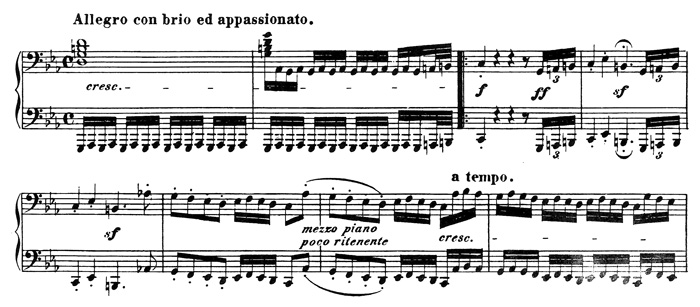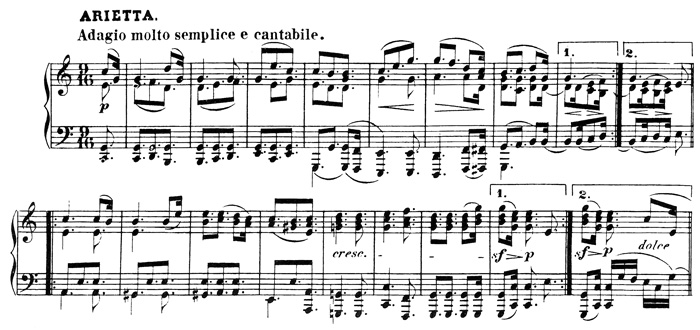Ludwig van Beethoven
Piano Sonata No.32 in C minor, op.111
Media Review / Comparison
2014-10-04 — Original posting (on Blogger)
2014-10-05 — Added link to summary posting
2014-10-24 — Addendum, pointing to concert reviews
2014-11-13 — Re-posting as is (WordPress)
2014-11-19 — Added Igor Levit, amendments & minor corrections
2015-08-20 — Added reference to Brautigam’s complete sonata recording
2016-07-28 — Brushed up for better readability
2022-07-02 — Corrected recording date for Artur Schnabel (thanks to John Grabowski for the feedback / input!)
Table of Contents
Introduction / The Recordings
This posting is one of a series covering the recordings of Beethoven’s piano sonatas in my music collection, about the Sonata No.32 in C minor, op.111 — references to the CDs are given in the respective section or in one of the related postings. For links to all related postings see “Beethoven: Piano Sonatas, Summary“.
This posting is about Ludwig van Beethoven‘s Piano Sonata No.32 in C minor, op.111, of which I currently have 11 recordings, discussed here in the sequence of the artist’s last name.
Chronological Sorting
- Artur Schnabel (1932)
- Wilhelm Backhaus (1961)
- Wilhelm Kempff (1964)
- Friedrich Gulda (1967)
- Julius Katchen (1968)
- Paul Badura-Skoda (1969)
- Maurizio Pollini (1976)
- Daniel Barenboim (1984)
- Ronald Brautigam (2008)
- András Schiff (2012)
- Igor Levit (2013)
Backhaus, Gulda, Pollini and Schnabel were also present in my LP collection, the others were added as CDs only, in order to have a broader scope for a comparison. Igor Levit is the latest addition — on the occasion of his concert performance in Zurich.
Background, About the Composition
Ludwig van Beethoven (1770 – 1827) wrote the bulk of this last piano sonata, the Piano Sonata No.32 in C minor, op.111, in 1821/22 — in terms of piano compositions, “only” the Diabelli Variations (op.120) and two sets of Bagatelles (op.119 and op.126) were to follow.
The Movements
Among Beethoven’s late piano sonatas (op.101ff.), this is the only one with just two movements:
I. Maestoso (4/4) — Allegro con brio ed appassionato (4/4)
The first movement starts with a rather harsh Maestoso introduction:
After 15 bars, a rumbling bass trill (think of that on a period instrument!) leads to the exposition of a sonata movement, annotated Allegro con brio ed appassionato:
II. Arietta: Adagio molto semplice e cantabile (9/16)
This second (and Beethoven’s last) sonata movement is in C major, not in C minor. It uses unusual time annotations, such as 9/16, 6/16, even 12/32 — and it is one of Beethoven’s most beautiful, serene creations — an Arietta (16 bars), followed by 9 variations, all dominated by small note values. Here’s the Arietta:
The Tempo
Once more, the tempo annotation raises issues, as there is no metronome mark by the composer. One can tell the difficulty just by reading literature: The Wikipedia entry refers to Adagio molto, semplice e cantabile, but when we inspect the autograph, we clearly see Adagio molto semplice e cantabile, i.e., there is no comma, and even from the spacing between the words (readable, for once!) one can tell that it is not meant to be Adagio molto with the attributes semplice e cantabile (“very calm, simple and singable”, which in Italian could easily be clarified as Molto adagio[,] semplice e cantabile), but rather “calm (adagio), very simple and singable”.
That of course still leaves ample room for interpretation — but maybe it is worth adding another reminder: Adagio means “calm”, not “slow”. The latter would be written as Lento — a very rare annotation with Beethoven (thanks to Sir Roger Norrington for reminding me of this through his introductions to the Beethoven symphony performances in Stuttgart!). On the other hand, variation 1 is a close continuation to the Arietta and has no tempo annotation, variations 2 (6/16) and 3 (12/32, see below) are explicitly marked L’istesso tempo (i.e., no tempo change), thereafter the time signature returns to 9/16, and there is no additional tempo annotation; with this, one does indeed end up with a relatively slow Arietta.
The Variations
Just like the theme, the first three variations all consist of two repeated parts (AABB). The third variation is the one with the most extravagant time annotation, 12/32:
Interesting, those repeated syncopations: that’s about as jazzy as Beethoven ever got — even with a venerable artist such as Wilhelm Backhaus!
Major parts of the remaining variations (without repeat signs) are dominated by chains of demisemiquaver triplets:
The movement ends with descending octave scales, and a short reminiscence of the initial Arietta theme:
The Interpretations, Overview
In order to provide a rating overview, as well as an idea about tempo relations both within an interpretation, as well as between the two recordings, I have prepared the table below. For each artist, the upper row is the rating (gray=1, yellow=3, orange=5), the lower row shows the tempo, with color coding (blue = slower, white = average, green = faster):
The metronome readings are approximate; in the case of the second movement, only the tempo of the Arietta was measured / estimated.
The Interpretations, Detail
With most pianists in this review (Wilhelm Backhaus, Paul Badura-Skoda, Daniel Barenboim, Ronald Brautigam, Friedrich Gulda, and Artur Schnabel) I have their (or one of their) complete recording(s); Wilhelm Kempff and András Schiff also have recorded the entire set of Beethoven sonatas, but op.111 is the only one in my collection with these artists. Maurizio Pollini is more selective — the sonata here was released as part of his legendary recording with the late Beethoven sonatas from 1976. Julius Katchen is well-known for his recording of Johannes Brahms’ complete works for piano; he has recorded all five piano concerti by Beethoven, but (to my knowledge) not all of the 32 piano sonatas — the sonata op.111 is included with his recording of the Diabelli Variations, op.120.
Wilhelm Backhaus (1961)
Beethoven: The 32 Piano Sonatas
Decca 473 7198 (8 CDs, mono / stereo); ℗ 1953 – 1969 / © 2006
Booklet: 28 pp. e/f/d

For general information on Wilhelm Backhaus‘ complete recording of all Beethoven piano sonatas see the post “Beethoven: Piano Sonata No.15 in D major, op.28“. This sonata was recorded 1961.
Notes on the Movements
I. Maestoso (4/4) — Allegro con brio ed appassionato (4/4)
Duration: 8’17”
The Maestoso lacks all tension — how nice it would be if the artist were to hold back the note after a rest for a fraction of a second! In the beginning of the Allegro part, there is a tricky chain of semiquavers with six sf on downbeats — Backhaus instead places the sforzati on the peak notes, which erroneously makes this sound like a chain of triplets (an error that several other artists also make, to some degree!).
II. Arietta: Adagio molto semplice e cantabile (9/16)
Duration: 13’09”
A very unique interpretation, unlike all others: very fast — more than twice as fast as Barenboim, in fact! Backhaus starts slow, but then rapidly accelerates over 3 – 4 bars, then slows down again for the repeat: extreme tempo variations may be an expression of Zeitgeist. Somehow, the fast tempo makes sense, as it turns the theme into a singable melody — cantabile, indeed! Some of Backhaus’ soft articulation (sometimes also arpeggiando) may also be an expression of Zeitgeist — Backhaus’ playing is certainly not rhythmically over-accentuated. Despite some of these flaws: it remains a great interpretation, with one single, big dramatic arch / flow over the entire piece!
Overall Duration: 21’26”
Rating (see above for details): 3.0 — Certainly not a model for current interpretations, but an interesting, valuable historic document!
Paul Badura-Skoda (1969)
Beethoven: The 32 Piano Sonatas
Paul Badura-Skoda (Bösendorfer 290 Imperial)
Gramola 987 42/50 (9 CDs, stereo)
Booklet: 20 pp. d/e/f/Japanese

For general information on Paul Badura-Skoda‘s complete recording of all Beethoven piano sonatas see the post “Beethoven: Piano Sonata No.15 in D major, op.28“. This sonata was recorded 1969.
Notes on the Movements
I. Maestoso (4/4) — Allegro con brio ed appassionato (4/4)
Duration: 8’22”
In the Maestoso, some of the rests are cut short, which destroys the tension. The same applies to the Allegro part, where occasionally the tempo appears to “run away” (lack of tempo control?), and some of the articulation is too soft, sometimes inaccurate, especially in the fugato sections.
II. Arietta: Adagio molto semplice e cantabile (9/16)
Duration: 16’23”
The Arietta feels rhythmically static, the theme and the first two variations lack drive — there are too many ritardandi / slow-downs; variation 3 is clear despite the full sonority of the Bösendorfer 290 Imperial, and I definitely like the interpretation from variation 4 to the end: harmonious, makes sense, expressive, one big arch to the end.
Overall Duration: 24’44”
Rating (see above for details): 3.0 — Somewhat of a mixed bag, with some nice highlights.
Daniel Barenboim (1984)
Beethoven: The Piano Sonatas Nos.16 – 32
DG 413 766-2 (6 CDs, stereo); ℗ 1984
Booklet: 50 pp. d/e/f

For general information on Daniel Barenboim‘s complete recording of all Beethoven piano sonatas see the post “Beethoven: Piano Sonata No.15 in D major, op.28“. This sonata was recorded 1984.
Notes on the Movements
I. Maestoso (4/4) — Allegro con brio ed appassionato (4/4)
Duration: 10’02”
Slow rather than Maestoso; the Allegro part is often heavy, almost clumsy; the tone in general is rather dull, some of the semiquaver passages in the bass are a mere, unclear grumbling; to me, this recording exemplifies the problems that performing this sonata on a modern concert grand may pose (too much pedal, maybe, too?).
II. Arietta: Adagio molto semplice e cantabile (9/16)
Duration: 20’27”
In short: far too slow! This is not even Adagio molto (which is a mis-perception anyway, see the notes above), but Lentissimo, completely against the notation, and definitely not cantabile (a singer would be out of breath after two bars!), nor semplice: the melody is incomprehensible, even completely absent in variation 4. Enough said.
Overall Duration: 30’27”
Rating (see above for details): 1.5 — A really disappointing interpretation.
Ronald Brautigam (2008)
Beethoven: Piano Sonatas opp.101, 109, 110, 111
Ronald Brautigam (Fortepiano by Paul McNulty, 2007, after Conrad Graf, ca.1819)
BIS-SACD-1613 (SACD/CD); ℗ / © 2010
Booklet: 28 pp. e/d/f

Beethoven: The Complete Piano Sonatas
Ronald Brautigam (Fortepiani by Paul McNulty)
BIS-SACD-2000 (9 SACD/CD); ℗ 2004 – 2010 / © 2014
Booklet: en/de/fr

This is the last of the sonata CDs in Ronald Brautigam‘s (*1954) complete recording of all of Beethoven’s works for piano solo. Brautigam did this recording in 2008, on a fortepiano built by Paul McNulty (2007), after an instrument (opus 318) by Conrad Graf, from ca.1819. That’s a piano model that was also delivered to Beethoven in 1825. The instrument features una corda, single and double moderator, and sustain pedals and has a tonal range of CC up to f””.
Notes on the Movements
I. Maestoso (4/4) — Allegro con brio ed appassionato (4/4)
Duration: 8’20”
An excellent interpretation, as expected — exploiting the full advantages in the sonority and the fast response of the fortepiano! The interpretation is clear / transparent, has drive, is dramatic — I like it! A nice detail: in the Maestoso part, Brautigam uses the moderator for the p / pp segment, which not only attenuates the sound, but also makes the instrument sound softer, smoother. I give this movement a top rating, even though Brautigam does not aim for perfection — but, after all, expression is far more important here than technical perfection.
II. Arietta: Adagio molto semplice e cantabile (9/16)
Duration: 14’35”
In comparing to the other interpretations (excepting Backhaus), the first impression is that of “a little fast” — but then, I think that the tempo is perfectly adequate, fulfills the molto semplice e cantabile criterion, it is still Adagio, i.e., calm (not slow!), plus, it is adjusted to the singing sonority of the fortepiano, and also to its vastly better transparency; excellent agogics, and once one has adapted to the tempo (as a listener), there isn’t any sense of rushing. Variation #3 (the “jazzy” one) is maybe close to the limit of playability. Sometimes it is at the limit of being rhythmically slightly “flat” (though one should keep in mind that the fast figures are 2 + 1 hemidemisemiquavers, not 3 + 1, as in ordinary punctuations!).
Brautigam also highlights the dynamic annotations (never ex cathedra, though!). The long, leggiermente demisemiquaver chains are really light, and the left hand never covers lucid figures in the right hand. Around the last climax, the p annotations are interpreted more relative (to the alternating f) than as real soft — understandable, given the emotional content at that point. An excellent interpretation, very impressive — though not as emotional and touching as Pollini’s — but that could hardly be produced on a fortepiano: to me, both are legitimate solutions.
Overall Duration: 23’25”
Rating (see above for details): 5.0 — Clearly my favorite, along with Pollini’s (for the second movement).
Friedrich Gulda (1967)
Beethoven: The 32 Piano Sonatas, The 5 Piano Concertos
Friedrich Gulda,Horst Stein, Vienna Philharmonic
Universal 476 8761 (12 CDs, stereo); ℗ / © 2005
Booklet: 2 pp. + Track listing German

For general information on Friedrich Gulda‘s complete recording of all Beethoven piano sonatas see the post “Beethoven: Piano Sonata No.15 in D major, op.28“. This sonata was recorded 1967.
Notes on the Movements
I. Maestoso (4/4) — Allegro con brio ed appassionato (4/4)
Duration: 8’38”
An excellent interpretation, rhythmically the most accurate (one of the few who follow the score with the six sforzati in the semiquaver chain at the beginning of the Allegro part!), dramatic, with drive, tension, good phrasing. The one downside is that in his impulsive playing, Gulda’s completely ignores clanging / rattling strings (sonority), which some might call un-esthetic — on the other hand, there is hardly an interpretation that closes the movement with so much preparation / expectation for the following Arietta!
II. Arietta: Adagio molto semplice e cantabile (9/16)
Duration: 15’32”
The piano appears slightly “sharper” (a tad out of tune?) compared to Pollini’s. In the Arietta, I sometimes sense a very slight impatience (not caused by the slightly faster tempo) — but at least, Gulda never drops the (at)tention in this movement! He uses stronger agogics than Pollini, and needless to say: in the “jazzy” variation #3 Gulda is in his real element (maybe too much, even?)! Certainly dramatic, and working out the big phrases over the entire movement — though lacking Pollini’s emotional serenity and lucidity in this movement?
Overall Duration: 24’10”
Rating (see above for details): 4.0 — Excellent interpretation, but does not come close to Pollini in the second movement.
Julius Katchen (1968)
Beethoven: Diabelli Variations, op.120; Piano Sonata op.111; Polonaise in C major, op.89
Decca / iTunes download (mono, 256 kbps); ℗ 2006
(no booklet)

The iTunes download of Beethoven’s Diabelli Variations, op.120 by Julius Katchen (1926 – 1969), a recording made in 1960 (originally on a separate LP), associates the composer’s last sonata in C minor, op.111, and the Polonaise for piano in C major, op.89. On LP, these two compositions were originally grouped with the Bagatelles, op.126. Katchen recorded Beethoven’s op.111 and op.89 in 1968, a year before succumbing to cancer.
Notes on the Movements
I. Maestoso (4/4) — Allegro con brio ed appassionato (4/4)
Duration: 8’42”
A good interpretation, with drive and tension, technically excellent — with more clarity than some of the stereo recordings, maybe at times almost too forceful? One minor point of criticism: like others, he lacks clarity in the six sforzati in the semiquaver chain at the beginning of the Allegro part, making that passage sound like a chain of triplets, or like syncopes.
II. Arietta: Adagio molto semplice e cantabile (9/16)
Duration: 16’44”
The initial Arietta is good — but later in the movement, Katchen tends to overload the piece. He is showing expression rather than serenity, ignoring dynamic notations in the score (sometimes playing f when the score asks for p). Also, the tempo concept is questionable: the Arietta is played at 3/16 = 38, the first variation with 3/16 = 45, the second one (6/16, explicitly annotated L’istesso tempo) with 2/16 = 50, the third one (12/32, again marked with L’istesso tempo) with 4/32 = 55, the fourth variation (9/16 again) returns to 3/16 = 50, etc. (always counting three beats per bar — this is the only measure that really makes sense here).
I can understand an artist taking some freedom in interpreting L’istesso tempo — but here, I sense some disconnects. Interestingly, Pollini varies the tempo even more — but there, it all makes sense: the “disconnect” therefore must be in the way in which Katchen makes the transitions between the variations.
Overall Duration: 25’24”
Rating (see above for details): 3.0 — I like the first movement more than the Arietta.
Wilhelm Kempff (1964)
Beethoven: The 5 Piano Concertos, Piano Sonata op.111
DG 427 237-2 (3 CDs, stereo); ℗ 1962, 1964
Booklet: 2 pp. + Track listing German

The recording of the Beethoven piano concertos by Wilhelm Kempff (1895 – 1991) from 1962 includeshe composer’s last piano sonata in C minor, op.111. This recording dates from 1964.
Notes on the Movements
I. Maestoso (4/4) — Allegro con brio ed appassionato (4/4)
Duration: 8’56”
In the Maestoso, Kempff ignores Beethoven’s pedaling instructions, some of the fast (demisemiquaver) chords are rhythmically incorrect. In the Allegro part, some staccati are ignored, the articulation in general is sometimes real sloppy (and often soft). Not much joy, overall.
II. Arietta: Adagio molto semplice e cantabile (9/16)
Duration: 15’24”
Kempff tends to shorten long(er) note values in the initial Arietta (theme), the music loses all tension. Also, the 9/16 time involves triplets — Kempff slightly over-punctuates in the Arietta: this is quaver + semiquaver, not a punctuated quaver! Variation 3 is rhythmically inaccurate, the articulation often too soft.
Overall Duration: 24’20”
Rating (see above for details): 1.5 — Can’t recommend this.
Igor Levit (2013)
Beethoven: The Late Piano Sonatas (opp.101, 106, 109, 110, 111)
Sony classical 88883747352 (2 CDs, stereo); ℗ / © 2013
Booklet: 40 pp. d/e/f

Igor Levit (*1987) recorded Beethoven’s late piano sonatas in 2013; for general remarks about the artist see my review for the concert on 2014-10-21.
Notes on the Movements
I. Maestoso (4/4) — Allegro con brio ed appassionato (4/4)
Duration: 9’28”
The very first notes (fast upbeats) give the impression of a relatively fluent tempo — but that is deceptive: the tempo in the Maestoso is very moderate, and in the second half of that section (starting in bar 12), Levit is slowing down pretty dramatically, losing all flow and perspective/expectation for the dramatic part that follows; as a general concept, this may be OK — but the score speaks a different language. On the other hand, throughout the movement Levit is exceptionally careful and differentiated in the dynamics. In the Allegro part, he articulates very carefully, the sforzandi in bars 25 – 27 are excellent, and in bars 32/33 I like Levit’s phrasing in the right hand, where he gives the first beat (quaver) in every group of four distinctly more time than to the remaining notes.
It sounds like a peculiarity with this artist that also in the Allegro part, he seizes every opportunity for a ritardando (offered by the score), making it more pronounced than most or all other artists: it may be done very carefully and with consideration — but to me as a listener, the music tends to lose drive & flow in these parts. So, overall, my impression about the interpretation in this movement is not bad, but still a bit mixed.
II. Arietta: Adagio molto semplice e cantabile (9/16)
Duration: 18’02”
Levit starts with a rather slow Arietta theme, rather static / metric. Dynamically it’s OK, but the molto semplice appears to forbid agogics — why? I suspect he wanted to keep the theme very simple, “naked” — the first variation then picks up tempo (going from 3/16 = 39 up to 3/16 = 48), now also using more agogics, more differentiation altogether. Strangely, variation 2 (6/16) is again noticeably slower (2/16 = 44) and static — the tempo alteration doesn’t make sense to me. The slow pace also leads to some (minor) tempo instabilities. Variation 3 (12/32, the “jazzy” one) is again faster (4/32 = 49), good, carefully played and articulated.
Variation 4 (9/16) is again slower (3/16 = 44) — this time, the tempo change is more natural, not so noticeable. The remainder of the movement is fairly good, though often on the slow side (where the Arietta theme returns, the artist has no choice other than to return to the initial, slow pace), and there are moments where the performance tends to lose drive perspective. In a concert this may be OK (in fact, I had a better impression from this movement in the concert!), but with the inherently bigger distance to the listener through the CD, the same concept may not work quite as well as in a live performance.
Overall Duration: 27’29”
Rating (see above for details): 3.0 — OK, hardly much more — not as successful as in a concert.
Maurizio Pollini (1976)
Beethoven: The Late Piano Sonatas (opp.101, 106, 109, 110, 111)
DG 449 740-2 (2 CDs, stereo); ℗ 1976 / © 1997
Booklet: 16 pp. e/d/f/i

Beethoven’s Piano Sonata No.32 in C minor, op.111, is part of Maurizio Pollini‘s (1942 – 2024) legendary recording of the composer’s late piano sonatas opp.101, 106, and 109 – 111. The original release of this recording was in 1976, in a box with 3 LPs.
Notes on the Movements
I. Maestoso (4/4) — Allegro con brio ed appassionato (4/4)
Duration: 8’47”
No doubt, this is technically the most perfect interpretation — Pollini’s technique is flawless, superb, impeccable, and (different from Gulda) he also keeps the sonority in this difficult movement under control. On the other hand, I find that there is a certain neutrality in this interpretation — it is less emotional / expressive than Gulda’s, it doesn’t have the same amount of drive and tension, and it often appears softer.
II. Arietta: Adagio molto semplice e cantabile (9/16)
Duration: 17’23”
The tempo is definitely at the lower limit, just about still cantabile (in the Arietta, at least). Interesting: Pollini sometimes uses a touch of arpeggiando playing — but reversed: here (contrary to Schiff’s arpeggiando), the melody is leading, the left hand follows the melody by a tiny fraction of a second — just barely audible, if at all, and I feel perfectly at ease with Pollini’s articulation. Also interesting: Pollini’s tempo alterations are bigger that Katchen’s (3/16 = 36 for the Arietta, 3/16 = 50 for the first variation, 2/16 = 60 for the second variation, then around 4/32 = 50 for the third, “jazzy” variation, then returning to the tempo of the Arietta), but here, it all makes sense — “my” problem appears to be in the way in which Katchen makes the transitions (see above).
Excellent playing, excellent phrasing, in one big arch / gesture spanning the entire movement, not too dramatic, not overdone, technically absolutely flawless (also respecting the pedaling instructions), yet engaged, never dropping the attention / tension, and paying attention to second voices / hidden melodies — to me, a masterpiece, and it lets Beethoven talk to me, almost touches me to tears!
Overall Duration: 26’10”
Rating (see above for details): 4.5 — When asked about my favorite interpretation on a modern instrument — I would not hesitate picking this one: a reference recording for the second movement!
András Schiff (2012)
Beethoven: Diabelli Variations, op.120; Piano Sonata op.111; Bagatelles, op.126
András Schiff (Bechstein, 1921)
ECM New Series 2294/95 (2 CDs, stereo); ℗ / © 2013
Booklet: 50 pp. d/e

In 2012, the Hungarian pianist András Schiff (*1953) recorded Beethoven’s Diabelli-Variations (op.120) twice on a single CD set — once on a historic fortepiano by Franz Brodmann (ca. 1820), and once on a Bechstein concert grand from 1921. The latter was Wilhelm Backhaus’ favorite piano prior to World War II. It survived the war in Berlin. The CD with the recording on that latter instrument combines the Diabelli-Variations with Beethoven’s last piano sonata — the one in C minor, op.111. The other CD combines them with the Bagatelles op.126. Some of the research that András Schiff did around the Beethoven piano sonatas was presented in a lecture series in Zurich and at Wigmore Hall in London — results from that research also perspire through his interpretation of op.111:
Notes on the Movements
I. Maestoso (4/4) — Allegro con brio ed appassionato (4/4)
Duration: 8’55”
Hmmm … I really, really like András Schiff’s lectures on the Beethoven sonatas, and the research results that he presents in these instructive talks! All this is clearly evident in this interpretation, which exemplifies the distinction between semiquaver- and demisemiquaver upbeats, the correct use of the pedal (as specified by the score), etc. Schiff’s playing is very clear, articulate, lucid, and very accurate, but over all this, the interpretation sounds totally ex cathedra, it lacks drive, tension, fire. Some of the movement sounds like a mathematical construct / exercise (something Bach sometimes did “for fun” in some of his fugues). I hate having my nose rubbed onto the difference between semiquavers and demisemiquavers, etc.!
Consequently, the tension is also lacking at the end of the movement, which just ends in a calando, without making the listener expect a movement like the Arietta. I can’t blame the interpretation for any technical deficiencies (and it’s good to have a reference showing the accurate text of the score), but I’m not really moved either.
Addendum: my remark regarding semiquavers vs. demisemiquavers refers to the last note in bars 2 and 4, where Schiff plays a semiquaver — I think in this case he is wrong: in my pocket score (Kalmus No.754, 1968), bar 4 indeed ends with a semiquaver — but this conflicts with the preceding double-punctuated eighth rest, while in bar 2 the score shows a demisemiquaver as last note: this must be a printing error, as the autograph (as far as I can tell) shows demisemiquavers in both bars (there may have been a late correction in bar 4, but a semiquaver upbeat does not make sense to me).
II. Arietta: Adagio molto semplice e cantabile (9/16)
Duration: 17’30”
Good tempo relations — but why is Schiff using that much arpeggiando articulation? To me, this defeats the molto semplice aspect of this movement — and it is far too prominent (and used too frequently) here! Also, there are rhythmic inaccuracies in the “jazzy” third variation (especially the last notes in those ascending or descending punctuated runs).
Overall Duration: 26’24”
Rating (see above for details): 3.5 — I was hoping for more…
Artur Schnabel (1932)
Beethoven: The 32 Piano Sonatas
Artur Schnabel (recorded in London, 1932 – 1937)
Regis / Forum FRC 6801 (8 CDs, mono)
Booklet: 8 pp. (mostly track listing) English

For general information on Artur Schnabel‘s complete recording of all Beethoven piano sonatas see the post “Beethoven: Piano Sonata No.15 in D major, op.28“. This sonata was recorded 1932.
Notes on the Movements
I. Maestoso (4/4) — Allegro con brio ed appassionato (4/4)
Duration: 8’15”
In the Maestoso, Schnabel overpunctuates the upbeats (certainly a deliberate action), he meticulously observes the pedaling instructions, though he ignores some of the staccato dots. In the Allegro part, the six sforzati in the semiquaver passage are not misplaced (as with, e.g., Backhaus), but rather ignored. Schnabel uses a distinct “emotional rubato“, with sudden accelerandi or tempo jumps, which sometimes causes the movement to lose some tension. The articulation (along with the rubato) shows clear signs of Zeitgeist. Today, this might be regarded as sloppy or superficial — nevertheless, one can sense a strong concept in this interpretation, which is still impressive, as well as very expressive!
II. Arietta: Adagio molto semplice e cantabile (9/16)
Duration: 17’42”
The theme is definitely on the slow side, but rhythmically very accurate. Variation 1 then continues substantially faster (3/16 = 54). Between variations 1 and 2, the flow stops (possibly because the recording needed to be split at this point?), the second part of variation 3 occasionally loses some drive, but then, from variation 4 on, the interpretation is dramatic and expressive up to the end — very impressive, overall, even though one can sense some Zeitgeist in Schnabel’s rubato.
Overall Duration: 25’55”
Rating (see above for details): 3.0 — Maybe not Schnabel’s best interpretation of a Beethoven sonata — but impressive nevertheless!
Addendum 1
In a piano recital at the Tonhalle in Zurich, on 2014-10-21, Igor Levit played Beethoven’s piano sonata op.111 — see my concert review (in German) on Bachtrack.com, “Ein Beethoven der verhaltenen Töne – Igor Levit in Zürich“. As this is in German, I have written up a separate, more extended review in the posting “Igor Levit, Tonhalle Zurich, 2014-10-21”.
Addendum 2
For the non-pianists: I use pocket scores (typically Lea Pocket Scores or Kalmus) to follow this music. Beethoven’s 32 Sonatas are spreading over five volumes:
- No.1 – 6: —Find pocket score on amazon.com (#ad) —
- No.7 – 12: —Find pocket score on amazon.com (#ad) —
- No.13 – 20: —Find pocket score on amazon.com (#ad) —
- No.21 – 27: —Find pocket score on amazon.com (#ad) —
- No.28 – 32: —Find pocket score on amazon.com (#ad) —
































